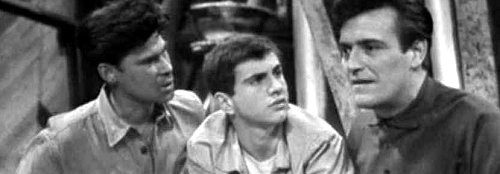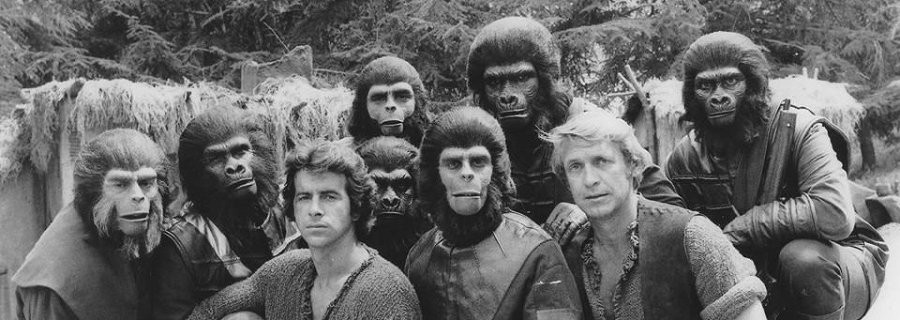
The Stranger
1964 - AustraliaReview: Daniel Tessier
Not many people around the world would immediately associate Australia with science fiction. Over the years, though, there have been a number of popular sci-fi TV series produced and filmed in Australia, many of them for children's television. In the 1960s, the Australian Broadcasting Commission (now Corporation), or ABC, began producing its own sci-fi programmes in response to the growing popularity of American and British imports.

The Stranger was the first such programme produced by the ABC, and one of the first Australian series to be sold overseas. The ABC website itself calls it “Australia's answer to Doctor Who,” which had been broadcast down under since early 1965, just over a year after its BBC debut. There are certainly similarities to Doctor Who, and The Stranger was itself sold to the BBC. However, The Stranger was first broadcast in its home country in April 1964, almost a year before Doctor Who, although it's not impossible that writer G. K. Saunders, born in New Zealand but with ties to England, had seen some early episodes. After years languishing in the ABC archives, The Stranger has become available again, thanks to its remastering by the team RetroFocus, who have made the archive film fit for broadcast standards. The ABC have made it available on their own online service ABCi, and for worldwide viewers on YouTube.

The Stranger begins when schoolmaster Mr. Walsh (John Faassen) find an unconscious man on his doorstep, and brings him into his home. The eponymous Stranger is played by Ron Haddrick, whose first starring role had been Dr. William Redfern in period drama The Outcasts in 1961. Immediately he comes across as alien, in the foreign if not extraterrestrial sense, speaking English fluently but with an accent and the slightly off manner of someone for whom it is a recent second language. He befriends Walsh and his children Jean and Bernie, and their friend Peter Cannon. These very mature-looking teenagers, played by Janice Linnen, Bill Levis and Michael Thomas respectively, take to the Stranger straight away. Mr. Walsh even offers him a job at his school. It's all a little too easy, and it becomes clear that the mysterious character is neither as amnesiac nor as helpless as he seems. He even displays some hypnotic powers, which allows him to ingratiate himself so easily into the Walshes' lives.
There's certainly some similarity between the Stranger and the Doctor, not least their slightly sinister characteristics which are downplayed over time. Unlike the Doctor, however, the Stranger quickly gains a name: Adam Suisse (seemingly because he sounds a bit Swiss to the Ozzie characters, and speaks German and French) and he sticks to this human alias throughout. Unlike the Doctor, Adam doesn't immediately whisk the characters across the universe, with the bulk of the episodes taking place on Earth. Between his lessons at the school, Adam periodically goes bush-walking, and maintains radio contact with persons unknown, leading the teens to follow him and discover his true nature as an alien visitor to Earth.

As you'd expect from a 1960s drama, it's all quite slow-paced in its presentation, yet the actual plot moves rapidly, so the series manages to be somehow slow and fast at the same time. With only six episodes in each of its two series, it's very hasty to get through the important plot points. We're not far into the first series before we learn that Adam is a visitor from Soshuniss – less a planet, more an escaped asteroid or moon – and one of a tiny handful of survivors of a devastating war. This is, of course, a standard sci-fi anxiety in the 1960s, if one that's still potent, but the main focus is on how these aliens are treated by the people of Earth. They are explicitly positioned as immigrants and refugees, only looking for a place to settle down and happy to provide technological secrets by way of a trade. Nonetheless, they are treated with suspicion and mistrust by many of the humans they encounter.

Adam is a compelling character, with Haddrick making him both charismatic and alien, and as mentioned before, just a little sinister in the earlier episodes. There's a little of Sherlock Holmes in his good-natured aloofness. More fun though is his fellow visitor Varossa, an excitable joker played by theatrical performer Reg Livermore. When we visit Soshuniss, we meet its leader, the wise Soshun (Mary Mackay), and while the aliens speak to the human children in English, they converse with each other in their own language. All episodes are directed by Gil Brealey, and there's an undeniable Australian feel to everything, with extensive location filming in the Blue Mountains area that must have been a big selling point for overseas viewers.

The second series, broadcast in 1965, has a noticeably higher budget and pushes the series into more open thriller territory, as the mistrust of the aliens gives way to open conflict as isolationist factions on both sides come to power. (The Soshun is replaced by a militaristic male played by Dynasty's Ben Gabriel.) The storyline, while still focused on Australia, opens out to include more of the world, and Brealey takes the opportunity to up the action. There's an amazing chase scene that takes place on the gigantic dish of the radio telescope at the Parkes Observatory – not a prop or a set, but the actual telescope. The Australian scientific research agency CSIRO assisted with the series' production, and the telescope appears in the title sequence, but to see it actually used this way is something else. It's amazing they were allowed to film the sequence, and it looks incredible.

While the second series is more ambitious in its style and action, the story remains focused on the same concerns. Immigration and the treatment of refugees was an ongoing source of controversy in Australia in the 1960s (the White Australia Policy, which policed immigration, wasn't truly overturned until 1966, and not legally ended until 1973) and has become so again in recent years. Indeed, with increasingly reactionary and conservative elements rising all over the world, the re-release of The Stranger is timely indeed. In spite of the odd pacing and understandable limitations of 1960s production, it's a fascinating and well-crafted drama with a timeless central concept.
Haddrick went onto become a reasonably famous face in Australia, appearing in several other sci-fi productions including 1972's Shirley Thompson Versus the Aliens, 1976's The Lost Islands (where he played the villainous Q) and the most famous Australian sci-fi series of all, Farscape (appearing the in the final miniseries, The Peacekeeper Wars). He was perhaps more famous for his voice, providing voicework for animations and narration for children's series, including Australian releases of Thomas the Tank Engine. Sadly, he died in February 2020, only days after The Stranger was re-released.

While Doctor Who became an international hit that continued to be produced and exported until the late 1980s, The Stranger, in spite of immediate popularity both at home and in the UK, faded into obscurity. The second series completed the story effectively, although there were certainly other avenues that following series could have explored, given the challenges alien settlers would experience living on Earth. Nonetheless, The Stranger never made the same long-lasting impact as many other 1960s sci-fi series, something that may now change.
Seen this show? How do you rate it?
Seen this show? How do you rate it?
Published on March 27th, 2020. Written by Daniel Tessier for Television Heaven.










